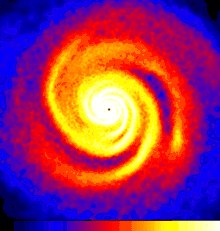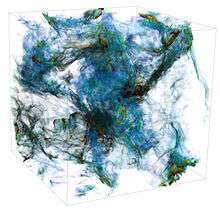Self-gravitation

Self-gravity is the gravitational force exerted on a body, or a group of bodies, by the body(ies) that allows it/them to be held together.[2] Self-gravity (self-gravitation) has important effects in the fields of astronomy, physics, seismology, geology, and oceanography.[3][4][5] Self-gravity has important impacts in regard to the physical behavior on large scale (planet size or larger) objects, such as the oceans on Earth[5] or the rings of Saturn.[4] The equation to calculate the effects of self-gravitation were made exact by Lynden-Bell[6] for the purpose of giving an exact description of models for rotating flattened globular clusters, which was a crucial step in understanding how clusters of stars interact with each other. Self-gravity deals with large-scale observations in fields outside of astronomy as well. Self-gravity does not typically appear as the central focus of scientific research, but understanding it and being able to include its effects mathematically increases the accuracy of models and understanding large-scale systems.
Astronomy

Self-gravity must be taken into account for astronomers because the bodies being dealt with are large enough to have gravitational effects on each other and within the bodies themselves. Self-gravity affects bodies passing each other in space within the sphere defined by the Roche limit because relatively small bodies could be torn apart by differential attraction, but typically the effects of self-gravitation keep the smaller body intact because the smaller body becomes elongated and the gravity of the body is able to overcome the momentum from this interaction between bodies.[2] This has been demonstrated on Saturn because the rings are a function of inter-particle self-gravity.[4] Self-gravity is also necessary to understand quasi-stellar object discs and how accretionary discs form and are stable and the role of self-gravity, as well as the importance of other factors in stabilizing these discs around quasi-stellar objects.[8] Self-gravitational forces are very important in the formation of planetesimals, and indirectly the formation of planets, which is critical to understanding how planets and planetary systems form and develop with time.[9] Self-gravity is very important on a range of scales, from the formation of rings around individual planets to the formation of planetary systems, and without fully understanding how to account for self-gravity, we will not be able to fully understand the system we live in on large scales.
Seismology
Self-gravity has important implications in the field of seismology as well because the Earth is large enough that it can have elastic waves that are large enough to change the gravity within the Earth as the waves interact with large scale subsurface structures. There are models made that depend on the use of the spectral element method[10] and these simulations take into account the effects of self-gravitation because it can have a large influence on results for certain receiver-source configurations and creates complications in the wave equation, particularly for long period waves. This kind of accuracy is critical in developing accurate 3-D crustal models in a spherical body (Earth) in the field of seismology, which allows for more accurate and higher quality interpretations to be drawn from data. The influence of self-gravity (and gravity) alters the importance of Primary (P) and Secondary (S) waves in seismology because when gravity is not taken into account, the S wave becomes more dominant and as gravity is taken into account, the effects of the S wave become less significant.[11]
Oceanography
Self-gravity is influential in understanding sea level and the ice caps for oceanographers and geologists, which is particularly important as we go forward trying to anticipate the effects of climate change.[3][5][12][13] The deformation on the Earth from the forces of the oceans can be calculated if the Earth is treated as fluid and the effects of self-gravity are taken into account and this allowed for the influence of ocean tide loading to be taken into account when observing the Earth's deformation response to harmonic surface loading.[13] The results of calculating post-glacial sea levels near the ice caps are significantly different when using a flat Earth model that does not take self-gravity into account, as opposed to a spherical Earth where self-gravity is taken into account because of the sensitivity of the data in these regions, which shows how results can drastically change when self-gravity is ignored.[3][14] There has also been research done to better understand Laplace's Tidal Equations to try to understand how deformation of the Earth and self-gravity within the ocean affect the M2 tidal constituent (the tides dictated by the Moon).[12] There have been suggestions that if the Greenland ice complex melts, the sea level will actually fall around Greenland and rise in areas further away because the effects of self-gravity .[5]
See also
References
- ↑ Rice, W., Armitage, P., Bate, M. & Bonnell, I. The effect of cooling on the global stability of self-gravitating protoplanetary discs. MNRAS, 339, 1025 (2003)
- 1 2 Chamberlin, T. C. The Planetesimal Hypothesis. Journal of the Royal Astronomical Society of Canada, Vol. 10, p.473-497. November, 1916.
- 1 2 3 Wu, P. & van der Wal, W. Postglacial sealevels on a spherical, self-gravitating viscoelastic earth: effects of lateral viscosity variations in the upper mantle on the inference of viscosity contrasts in the lower mantle. Earth and Planetary Science Letters, Volume 211, Issues 1–2, June 15, 2003, Pages 57–68.
- 1 2 3 Colwell, J. E., Esposito, L. W. & M. Sremcevic. Self-gravity wakes in Saturn’s A ring measured by stellar occultations from Cassini. Geophysical Research Letters, volume 33, April 1, 2006. L07201 p. 1-4.
- 1 2 3 4 Mitrovica, J., Tamisiea, M., Davis, J. & Milne, G. Recent mass balance of polar ice sheets inferred from patterns of global sea-level change. Nature 409, p. 1026-1029. February 22, 2001.
- ↑ Lynden-Bell, D. Stellar dynamics: Exact solution of the self-gravitation equation. Monthly Notices of the Royal Astronomical Society, Vol. 123, p.447. November, 1962.
- ↑ http://www.nas.nasa.gov/SC11/demos/demo37.html
- ↑ Goodman, J. Self-gravity and quasi-stellar object discs. Monthly Notices of the Royal Astronomical Society, Volume 339, Issue 4, pages 937–948, March 2003.
- ↑ Johansen, A., Oishi, J., Low, M., Klahr, H., Henning, T. & Youdin, A. Rapid planetesimal formation in turbulent circumstellar disks. Nature 448, 1022-1025, (August 30, 2007).
- ↑ Komatitsch, D. & Tromp, J. Spectral-element simulations of global seismic wave propagation—II. Three-dimensional models, oceans, rotation and self-gravitation. Geophysical Journal International, (2002) 150. p. 303–318.
- ↑ Freeman, G. Gravitationally Perturbed Elastic Waves. Bulletin of the Seismological Society of America. Vol. 57, No. 4, pp. 783-794. August, 1967.
- 1 2 Hendershott, M. The Effects of Solid Earth Deformation on Global Ocean Tides. Geophysical Journal International (published on behalf of the Royal Astronomical Society) (1972) 29, 389-402.
- 1 2 Pagiatakis, S. Ocean tide loading on a self-gravitating, compressible, layered, anisotropic, viscoelastic and rotating Earth with solid inner core and fluid outer core. Geodesy and Geomatics Engineering. July 1988. p. 1-146.
- ↑ Wang, H. & Wu, P. Effects of lateral variations in lithospheric thickness and mantle viscosity on glacially induced relative sea levels and long wavelength gravity field in a spherical, self-gravitating Maxwell Earth. Earth and Planetary Science Letters 249 (2006) 368–383.